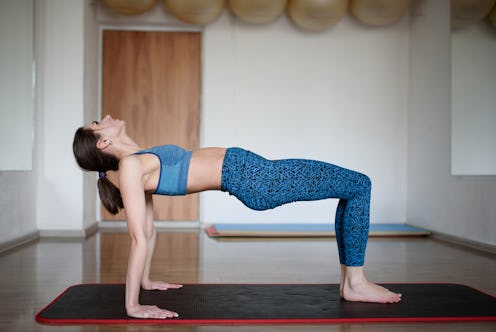Fitness
The Crab Walk Exercise Improves Your Posture & Overall Strength
Work those mussels. I mean muscles.

If you haven’t done a crab walk since summer camp, then it may be time to bring this old-school exercise back into your life. Yes, the move calls on you to do your best impression of a crustacean, but it comes with loads of benefits for your overall strength and mobility.
To scuttle as if you’re a shellfish under the sea, you start in a seated position with your hands and feet flat on the floor and your hips lifted, says Lalitha McSorley, PT, a physical therapist and personal trainer at Brentwood Physiotherapy Calgary. “You then move by alternating one foot and the opposite hand forward at the same time, which is similar to the movements of a crab,” she tells Bustle.
As you scurry along, you’ll strengthen your back and shoulders, arms and chest, core and glutes, and all the muscles in your legs. “When done regularly, it can improve overall posture as it requires you to engage your core muscles while maintaining proper form throughout the exercise,” says McSorley. “Not only that, but it also helps to increase your range of motion and flexibility.” That’s because the mini backbend of the move stretches out tight hips and shoulders.
Since the crab walk calls on lots of muscles at once, it effectively challenges your body’s stability and balance, says Michael Hamlin, NSCA, CSCS, a certified personal trainer and founder of Everflex Fitness. The exercise can also help improve your coordination and agility, he adds, since you’re holding yourself up in an awkward position. Read on for a guide on how to do the crab walk exercise properly so you can reap all the benefits.
How To Do A Crab Walk Exercise
Follow these instructions for nailing the basic crab walk, according to Hamlin.
- Sit on the ground with your legs bent in front of you and feet flat on the floor.
- Place both hands firmly behind you, fingertips facing forward and evenly spaced apart.
- Lift your hips off the floor.
- Begin the crab walk by stepping back with one foot and the opposite hand.
- Alternate by moving opposite hands and feet.
- As each foot moves back, press down into the ground to maintain stability in your upper body.
- Travel about 15 feet.
- Aim for 2 to 3 sets of 10 reps each.
The crab walk can feel slightly uncomfortable on your first try due to the weird positioning. If that’s the case for you, try easing into the move by starting in a low squat. As your hips open up, you can lean back onto your hands and slowly begin to lift one foot at a time off the floor, McSorley says. Once you feel warmed up, you can start to walk.
You can also modify the crab walk by moving at a slower pace — no need to race like you did when you were a kid! — and taking longer rest periods between each set. “You can reduce the number of reps per set if needed,” Hamlin adds. For a challenge, do the opposite by increasing your speed and the number of repetitions to challenge your muscles and add a cardio element. You can also use weights or resistance bands on your hands or ankles if you’re looking for a challenge.
Crab Walk Tips
The key to a good crab walk is to stay low. It’s common to want to lift your hips high, but that can strain the lower back, McSorley says. To do this move safely and effectively, she recommends keeping your hips down and your core and glutes engaged.
It’s also important to take breaks if your arms or legs start to get tired instead of continuing on with bad form, Hamlin says. “Try to keep up a steady pace throughout the entire exercise,” he says. When you’re finished, you should feel the burn in your mussels. I mean muscles.
Studies referenced:
Moghaddaszadeh, A. (2021). Guided Active Play Promotes Physical Activity and Improves Fundamental Motor Skills for School-Aged Children. J Sports Sci Med. doi: 10.52082/jssm.2021.86.
Tavares, N. (2022). Effectiveness of Therapeutic Exercise in Musculoskeletal Risk Factors Related to Swimmer's Shoulder. Eur J Investig Health Psychol Educ. doi: 10.3390/ejihpe12060044.
Sources:
Lalitha McSorley, PT, physical therapist, personal trainer at Brentwood Physiotherapy Calgary
Michael Hamlin, NSCA, CSCS, certified personal trainer, founder of Everflex Fitness
This article was originally published on